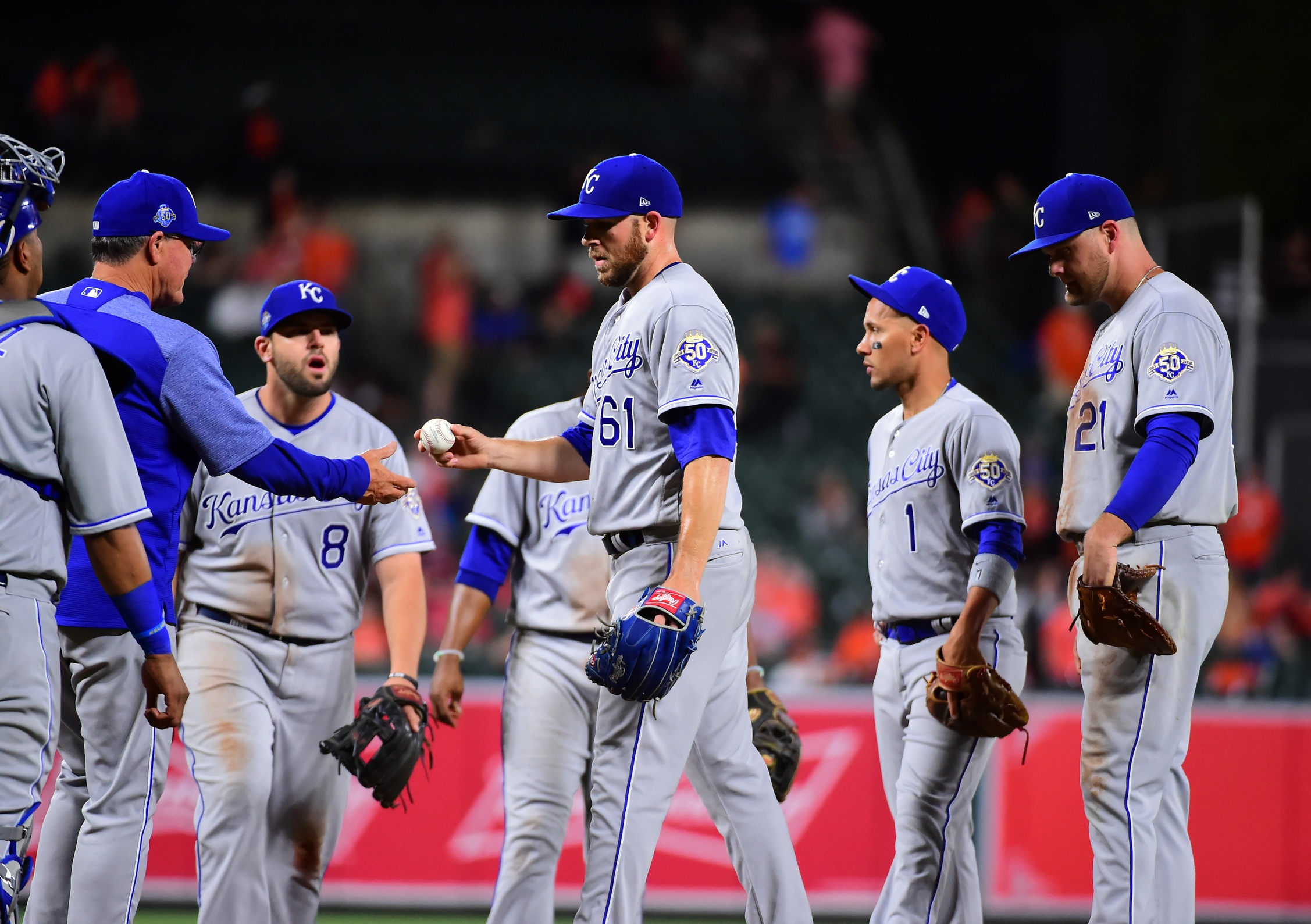Who knew games amongst the bottom feeders of the American League could be so compelling?
Monday’s smashball was downgraded to something resembling a pitcher’s duel on Tuesday. Here enters a familiar refrain, one we need to get used to as the season unfolds: It’s difficult to have confidence in the Royals once their bullpen (non-Kelvin Herrera edition) comes into play in a close ballgame. Ned Yost may have asserted his confidence in how his relievers lined up (potentially), but a two-out seeing-eye single begat a double, which begat the go-ahead runs on a single.
Ballgame.
Still, somehow, these Royals have maintained something of a never-say-die, bullpen-be-damned attitude.
Whit Merrifield draws a walk. Alex Gordon hits what should be a force out at second, but Jonathan Schoop can’t catch and the Royals are suddenly in business.
At least until you realize Alcides Escobar and Ryan Goins are the next two batters.
At this early stage in the season, Escobar has yet to settle at his usual spot at the bottom of the pile among offensive performers. He’s close. There are 169 batters who have had at least 110 plate appearances. (Baseball Prospectus stats pages don’t allow us to sort qualified hitters. The 110 PA number is what a current Royal batter would need to qualify.) Escobar’s .221 TAv ranks 152. Give him time.
Ryan Goins, on the other hand, has 102 plate appearances. If you’re wondering how in the hell does that happen, you’re not alone. Goins’ TAv is .217. As I noted back when the Royals signed the middle infielder to a minor league deal last winter, he and Escobar are practically indistinguishable at this point. And that’s not a good thing. Not when a game is on the line and you need a hit.
The Royals are clearly enamored with Escobar. His reputation as a defensive stalwart has bought him some goodwill. Apparently, old reputations die hard.
In Ned Yost’s postgame comments, he said the intention was for Escobar to bunt the runners over. I’m generally anti-bunt, but will concede there are situations where a well-placed sacrifice can possibly enhance a team’s chance of adding a run. However, there were two things working against the Royals in that situation.
First, Escobar isn’t particularly adept at bunting. Sure, he does it a lot (at least more than I like), but most of that is apparently freelancing on his part. Over the last five seasons, Escobar’s sacrifice bunt success rate is around 72 percent. League average is 66 percent. After his failed attempt in the third inning, he’s now 1-4 in sac bunt attempts this year. (His failure to lay down a bunt in the ninth does not count against him in the Baseball Reference stats.)
Second, you’re advancing the runners for Goins?
Goins is basically Escobar Lite. Entering play Wednesday, Goins had scored just two of 34 runners on base*. That’s a six percent base runner scored percent (BRS%), which is abysmal. He’s 0-4 in bringing home a runner from third with less than two outs.
(*-Ed. note: Both of which came in Tuesday night’s drubbing of Baltimore.)
In that situation, you’re better letting Escobar hit away, hope like hell he can avoid the double play – he’s about league average at hitting into a twin killing – and then pray to the baseball gods that you can somehow extend the inning to get Jorge Soler involved.
In the big picture, it’s not like this loss matters. There will be at least 90 of these this summer and by the end, they’ll all blur together.
We knew this season was going to be lopsided as far as the standings go and already the separation between the contenders and the tankers (or the legitimately trying to win games but doing it really poorly Royals) couldn’t be more extreme. Check out the run differentials for the top four teams in the AL against the bottom four.
| Team | Wins | Losses | RD |
| Astros | 24 | 15 | 79 |
| Yankees | 26 | 10 | 66 |
| Red Sox | 25 | 11 | 63 |
| Angels | 22 | 14 | 33 |
| Rangers | 15 | 24 | -52 |
| Royals | 12 | 24 | -52 |
| White Sox | 9 | 25 | -56 |
| Orioles | 9 | 27 | -78 |
There’s nothing predictive about run differential. It merely tells you part of a story of what has already happened. But in the case of these eight teams, it’s easy to buy into the narrative that these teams are exactly what we thought they would be. The Indians are hanging around .500 at a run differential of +8, but they’ve only played the Royals three times (that brutally cold series in early April where the two teams combined to score 10 runs in the three games), and they have yet to play the White Sox. The most compelling storyline among the strong teams in the league is probably the rebirth of the rivalry between the Yankees and Red Sox. Puke.
So we’re left to ignore records and run differential and the stink of the Escobar/Goins tandem and find ways to be entertained. Tuesday’s first inning was certainly a reminder of how fun baseball can be when you move the sliders to “rookie” mode and start crushing center cut fastballs sitting in the low 90s. Wednesday’s game was was different in that it hung in the balance until Jon Jay offered at three pitches out of the strike zone. Both were eminently entertaining. Yet different. And it was all baseball.
